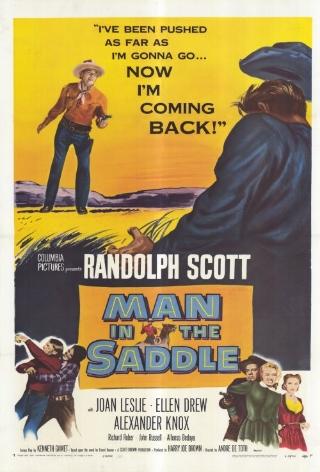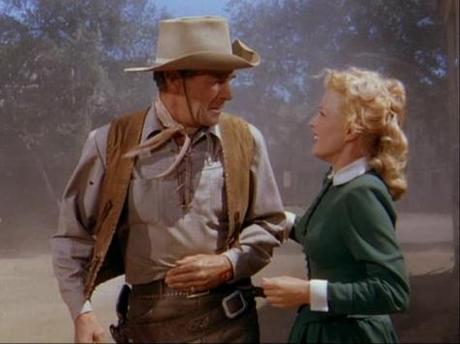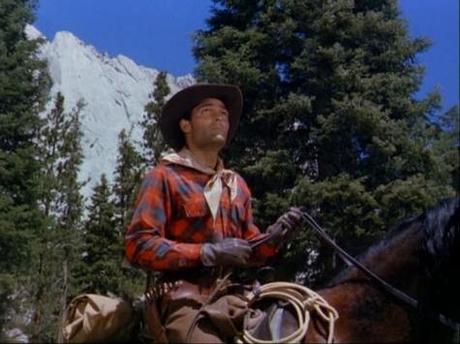
The collaboration of actors and directors is a favorite area for analysis by film critics – Ford and Wayne, Mann and Stewart, Huston and Bogart readily spring to mind. That attention tends to get focused on these cinematic partnerships is I think understandable; they offer a reasonably self-contained block of work which can be examined easily. Mention Randolph Scott to western fans and the name that will probably come to their lips is that of Budd Boetticher, again understandable enough given the reputation their series of films together has deservedly earned. However, Scott also made a group of westerns with another director, Andre de Toth, just before he hit his late career peak with Boetticher. Man in the Saddle (1951) was the first, and arguably the best, of a half-dozen movies featuring de Toth and Scott.
The overall framing device is the classic western staple of the range war, the conflict over land and the need for expansion. But that’s actually the least interesting aspect of a story that involves a number of overlapping and obsessive relationships. Owen Merritt (Randolph Scott) is a man under pressure on two fronts; having already lost his woman, Laurie (Joan Leslie), to his powerful neighbor Will Isham (Alexander Knox), he’s now in danger of seeing his ranch go the same way. Isham is one of those typical western expansionists, a man never satisfied with owning half of anything and ruthless enough to use whatever means are necessary to get what he wants. Standing in the path of this irresistible force is the immovable object of Merritt. The only possible outcome of such a paradox is conflict, even though Merritt does his level best to avoid it for as long as possible. What makes this apparently simple tale fascinating though is the way these characters, and those around them, interact. Merritt clearly retains strong feelings for the ambitious and mercenary Laurie, yet he buries them deep, while Isham is fighting an internal duel with his own jealousy and self-doubt. Matters are further complicated by the presence of another neighbor, Nan (Ellen Drew). She quietly pines for Merritt and in turn is herself desired by Clagg (John Russell), a taciturn loner of brooding temperament. When Isham’s hired gunmen up the ante by stampeding Merritt’s herd and killing one of his men all the passions and obsessions of the principals are unleashed. Merritt is forced into taking a stand against his enemies, even those he was hitherto unaware of.

If one views the westerns of de Toth and Scott in relation to the work both director and actor did independently and with others, then it’s possible to undervalue them. But I think such comparisons, even if they’re inevitable, are unfair. Movies really ought to be evaluated on their own terms – do they achieve what they set out to do? Placing them within a wider context does of course serve some purpose but it ultimately does the films a disservice too. What all that’s leading up to is my belief that Man in the Saddle succeeds in telling its tale. Firstly, de Toth’s direction and Charles Lawton’s cinematography combine well and the tension builds nicely. Visually, it’s an interesting movie with a number of scenes taking place at dawn or dusk (perhaps using the half-light to underline the murky, shifting nature of the relationships) and the location work in Lone Pine and Thousand Oaks particularly enhances the latter half. The climax too is notable for the use of a dust storm as an accompaniment to the action and is suggestive of the elemental, swirling emotions of those involved. The only downside of the film, for me at least, was the slightly clumsy way the comedic parts were integrated. Generally, I have no objection to the introduction of a little comedy to lighten the load, but I’m not sure it’s handled all that successfully in this case.
By the end of his career Randolph Scott had almost elevated the depiction of the stoic acceptance of loss and regret to an art form in itself. One of the more rewarding things about watching those films leading up this is the ability to observe how that persona gradually evolved over the years. As Merritt, Scott touches on this idea of losing the woman he loved. That loss isn’t as fully defined or as final as would be the case in the later movies with Boetticher, but it’s there all the same. Alexander Knox isn’t an actor normally associated with westerns, making only three throughout his career, yet he’s fine as Scott’s rival. He’s very convincing as an emotionally repressed man and this is even more effective when he actually lets loose all his pent-up rage. In truth, all the main players acquit themselves very well: Joan Leslie as the hard-edged pragmatist, Ellen Drew as the calm Girl Friday, and John Russell as the outsider twisted by his unrequited passion. My only complaint is that Richard Rober is underused as the smiling gunman.

Man in the Saddle is readily available on DVD and has been for many years. The US disc from Sony/Columbia presents the film nicely in its correct Academy ratio. This older transfer comes from a good print and boasts strong, vibrant color with plenty of detail. The disc doesn’t have much in the way of extra features, just a standard preview reel for other Sony/Columbia movies available. However, the movie is the main thing and the presentation here should give no cause for complaint. The westerns that Randolph Scott made with de Toth have been overshadowed to a large extent by the later Ranown cycle, yet they’re enjoyable in their own right. Aside from allowing viewers to fill in some gaps in tracing the development of the Scott persona, these movies are good examples of the professionalism to be found in the Hollywood western of the 50s. Man in the Saddle may not be the best thing Scott or Andre de Toth ever did but it’s still a pretty good film and is worthy of the talents of all involved.
